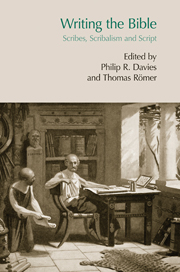Book contents
- Frontmatter
- Contents
- Abbreviations
- 1 Introduction
- I Writing in the ancient world
- 2 Ilimilku of Ugarit: copyist or creator?
- 3 Memory, writing, authority: the place of the scribe in Greek polytheistic practice (sixth to fourth centuries BCE)
- II Hebrew Bible and early Judaism
- III Early Judaism and early Christianity
- Index of biblical and other ancient sources
- Author index
2 - Ilimilku of Ugarit: copyist or creator?
- Frontmatter
- Contents
- Abbreviations
- 1 Introduction
- I Writing in the ancient world
- 2 Ilimilku of Ugarit: copyist or creator?
- 3 Memory, writing, authority: the place of the scribe in Greek polytheistic practice (sixth to fourth centuries BCE)
- II Hebrew Bible and early Judaism
- III Early Judaism and early Christianity
- Index of biblical and other ancient sources
- Author index
Summary
The scribes of Ugarit and their prodigious activity are among the things for which the city is rightly famous. It was the discovery of a small group of tablets, written in a hitherto unknown language using a cuneiform script, remarkably soon after excavations began on the tel of Ras Shamra, the site of ancient Ugarit, that led to the early realization of the importance of the site. The language, presumed to be the local language (and hence soon known as Ugaritic) was deciphered relatively rapidly, and it is probably true to say that it is the texts in Ugaritic, particularly the religious texts, that have occasioned the greatest interest, not least because of their potential relevance to the study of the Hebrew Bible. Subsequent excavations at Ugarit and nearby, for example at Ras Ibn Hani, have yielded numerous texts in a number of languages. In Ugarit itself, archives were found in the Royal Palace and related buildings, in the homes of government officials and other notable individuals, and in the house of the High Priest on the acropolis, between the temples dedicated to Baal and probably to Dagan, which may also have functioned as a scribal school.
The scribes of Ugarit used the cuneiform method of writing. A pointed reed would be used to impress signs on to a piece of suitably shaped damp clay. Their major contribution was the development of a much simplified script, compared with the much more complicated systems of ideograms and syllabic signs that had been used by their Mesopotamian neighbours.
- Type
- Chapter
- Information
- Writing the BibleScribes, Scribalism and Script, pp. 10 - 22Publisher: Acumen PublishingPrint publication year: 2013



